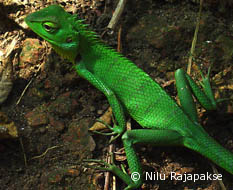Archive
The Bloodsucker or Garden Lizard of Sri Lanka
By R Chandrasoma.

Garden Lizard (Calotes versicolor)
The word ‘lizard’ has a popular connotation that is not very precise. The common gecko is sometimes called a ‘house-lizard’ by those weak in natural history. The truth is that the geckos form a distinctive family (the Gekkonidae) that stands apart from all other tetrapod reptiles. The same is true of those fearsome Dinosaur-like creatures called the ‘Monitors’ or Monitor-Lizards. They are Varanids (family Varanidae) and are believed to be related to the extinct ‘mosasaurs’ that luxuriated in ancient seas. In Sri Lanka the Kabara-goya (Varanus salvator – a close relative of the notorious Komodo Dragon) is known to all as a mighty but inoffensive creature with secret powers known only to those initiated in the black arts. An oil distilled from the fat of this reptile is much used by local sorcerers.
Let us briefly recall two other families of tetrapod reptiles that are well known if not well regarded. The skinks (family Scincidae ) are shiny-skinned and snake-like but possess two pairs of limbs which are rather feebly developed. Their movement is distinctively serpentine. Some of the larger skinks are beautifully patterned. It is difficult for outsiders to digest this, but skinks are held in dread and horror by Sri Lankans. The Sinhala name ‘Hickanella’ is mentioned in hushed tones as a kind of harbinger of death. In happy contrast, the Agamid lizards (family Agamidae) while not being great favourites with the general public, are not actively disliked. They are called ‘Katussas” by the natives – a somewhat hilarious term because lanky humans of the unpleasant kind are also called ‘katussas’.
Let us say something about the Agamidae before we discuss its special representative in Sri Lanka – the Garden lizard or Bloodsucker (Calotes versicolor). This bold and colourful reptile surely deserves a better place in our repertory of animal favourites. There are about 15 species of Agamids in Sri Lanka out of which 12 are supposed to be endemics. This is a remarkable confirmation of a little-known fact that our Island is a global hotspot for herpetological speciation.

Calotes versicolor (Juvenile)
How are these Agamids identified? Let us note first that they have the classic looks of a ‘lizard’ – in proof of which the photograph reproduced above is convincing evidence. Technically, the Agamids are united by a ‘synapomorphy’ involving the attachment of their teeth. The teeth are fused to the skeletal framework of the jaw. In contrast, the New World group – known as the Iguanidae – have laterally-placed ‘socketed’ teeth. The iguanas are often confused with the Agamids and the Varanids but any resemblance is due to homoplasy or convergence.
Now that we have a definition, let us glance at the leading Agamids of Sri Lanka. Alas, most of the species and genera that are zoologically interesting lead cryptic lives in specialist niches of the forest, scrubland and rock-filled redoubts. Little is known about them. In contrast to this gloom, the genus Calotes is – if not spectacularly evident – common enough to be part of popular folklore. There are six species of Calotes of which two –Calotes versicolor and Calotes calotes are common enough to arouse attention even among the indolent.

Calotes calotes
Calotes calotes (called ‘pala katussa’ by the natives) is a large handsome lizard in brilliant green. Alas, it is rarely found in gardens. I last saw this elegant creature many years ago high up a large palm that had its crown conveniently placed opposite the open window of a three-storied building. It was before the digital age and I was sadly bereft of recording devices. Let us pass on to Calotes versicolor. This species has a benign and friendly relationship with humans and it is possible to bring a digital camera within inches of the reptile with no untoward reaction. It looks but does not move. Below is a picture of the head of our reptilian friend taken at night-time.
